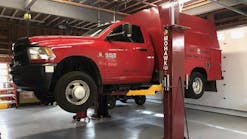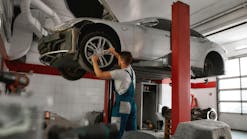How automation can help with the lack of auto repair technicians
Content brought to you by Motor Age. To subscribe, click here.
What you will learn:
• How we can lessen the effects of the technician shortage
• Streamlining day-to-day shop operations will increase technician productivity
• Changes aren't always easy or comfortable, but they may be necessary
The technician shortage is nothing new. As a matter of fact, if you search on the internet, you will see it being mentioned as much as a decade ago. It's just in the last few years that it's really started to hit home. Unfortunately, this situation is going to be with us for a good number of years to come, so we’d best get used to it and consider ways that we can lessen its effect on business.
Enough has been said about starting to get people interested in the automotive field to fill all these empty positions, so we're not going to talk about that here. Instead, we're going to talk about other ways your shop can succeed even with the current tech shortage.
Make it easier for your technicians to focus on their work
The first thing we need to recognize is that the technician working in the bay is the keystone to a shop’s existence. If you really think about it, everything, including the work bay, is there to support the technician in doing his or her job, whether it’s diagnosing, repairing, and/or maintaining vehicles. This is the “service” that brings in all the money for the shop. In essence, everything about the shop is really there to support the technician, so he or she can do his or her job as efficiently as possible.
I haven't forgotten about parts; their sale also helps support the facility. However, this also depends on the skills and talent of the technician to determine what is needed to service and repair each vehicle.
Not only are the advisors the technicians' communicators, but in their own way, they magnify the dollars brought in by the technician. They do this by upselling both needed and additional services to the customer. They are also dependent on the technicians’ abilities to do their job.
With all this being the case, it comes down to making it as easy as possible for technicians to focus on their work. This means being able to provide a constant flow of vehicles to work on, along with taking away all distractions and non-technical things that we currently require the technician to do. It also means giving them the tools that they need right in the bay so less time is spent walking around the shop getting access to information and other needed support.
Examine and change your service process
Where should the shop start to make changes that are going to help the technician focus on his or her main job? I recommend looking at and changing the actual service process that a vehicle must go through every time it comes to the shop, especially if your shop is still doing service pretty much the same way it has for years.
If your shop is doing any of the following day in and day out, it is really time for you to reconsider your service process because each of these items can negatively affect your techs:
- When customers call in for an appointment, are you still using a paper calendar?
- Are you writing customers up at the desk and producing paper estimates and invoices?
- Do your techs need to write everything down on a repair order or paper inspection?
- Calling customers and leaving messages hoping they will get back to you to authorize repairs?
Each one of these listed examples presents roadblocks to the flow of the service process and has a direct effect on the job of the technician. The good news is that technology can automate many of these items, keeping your techs busy doing what they do best.
It’s not only the automation aspect of technology that will help the tech; there are a number of other options of going to a digital service method that will free up time and keep the tech busy.
Digital technology gets more customers to come back
To keep the tech busy, you need to get customers to return. Returning customers buy more. Digital technology provides a number of different ways to automate getting your customers back.
The oil-change sticker has been the most used method to get customers back, but in reality, it doesn’t work that well, as it depends on the customer to actually pay attention to it, but because there are some people that the sticker does work for, we don’t want to get rid of it; we just want to put some automation behind it.
When the sticker is printed, technology can do a number of different things with that one action. It can set the vehicle’s next appointment in the shop’s management system based on average miles driven per day, and the type of oil used. The recommendation for the return visit goes right into the future service required fields of the RO and sets an automatic reminder text message that goes out to the customer a week in advance of the appointment. Additionally, the software can be set up to set both recommendations and appointments for any other jobs with repeating intervals with the same “click.”
When the customer gets the reminder text message, he or she can confirm they are coming in for the appointment by responding with the letter “C,” as in the word “confirm.” When the shop sees this confirmation, they can look over the what the vehicle is coming in for and pre-order any needed parts. Having all the parts immediately available to the technician when the vehicle arrives will save quite a bit of time.
Remove paper from the service process to increase technician uptime
Eliminating paper from the service process is another way that going digital can improve technician efficiency. The tech doesn’t need to lose time looking for the next job since it pops up right on their tablet. Before he or she even gets to the vehicle, he or she can start looking up service repair information on the tablet to plan the approach to any diagnosis or needed specifications.
All of the translating tech scratch and copying it from the paper repair order and into the management system is gone. Techs can input their findings using canned notes, voice-to-text, pictures, and videos with digital inspections. When set up properly, the digital inspection can automatically put all recommendations in the management system, setting customers up for return visits. Next, by sending the inspection to the customer via text, the descriptions and pictures educate customers on what is being offered, building trust, and getting quicker authorizations.
The tech no longer needs to go and stand by the service desk trying to get the advisor’s attention for okay's and estimates. All the information gets sent to the desk digitally from tablet to PC while the tech continues to work on the vehicle, using the preordered parts that are waiting for the vehicle, not the vehicle waiting for parts.
These are just a couple of ways that going to digital automation can make your service process more efficient by boosting the capabilities of the staff you already have, possibly delaying the need for hiring new staff. This increase in revenue means everyone can see a bump in their income, perhaps reducing the chances of them leaving your shop for another. The best part is once it’s in place, the digital service method does this automatically.



